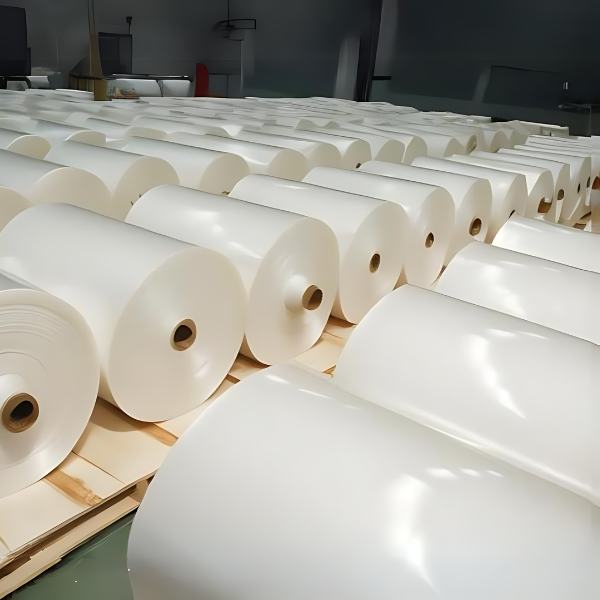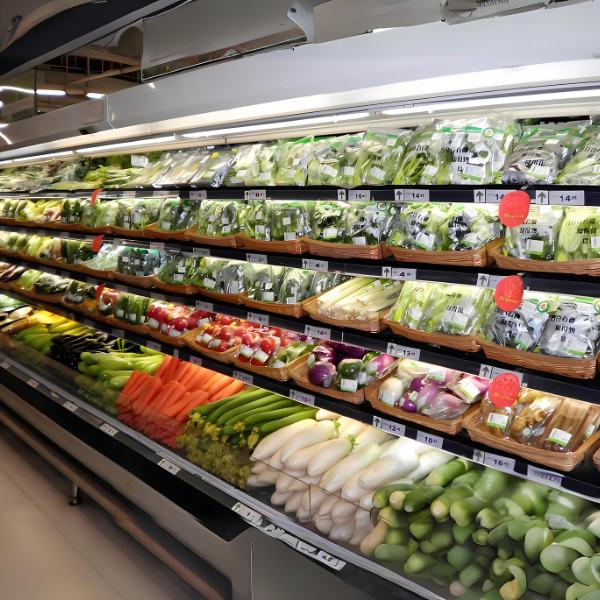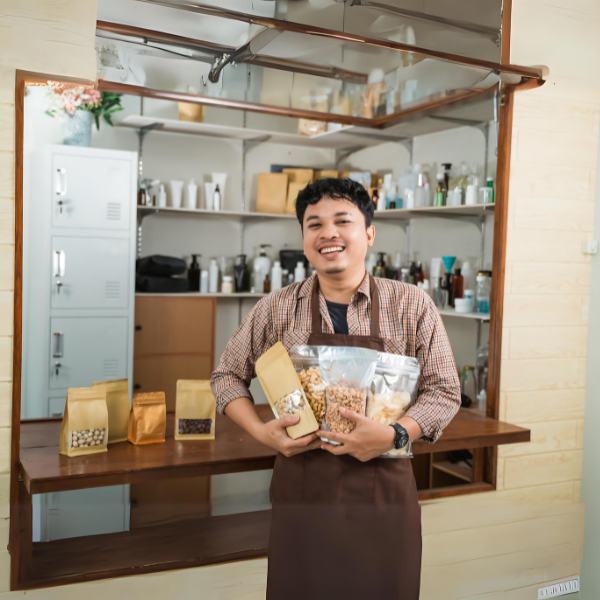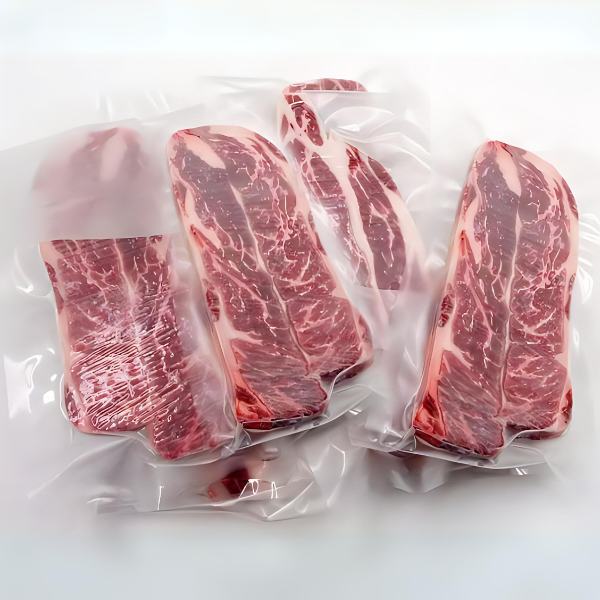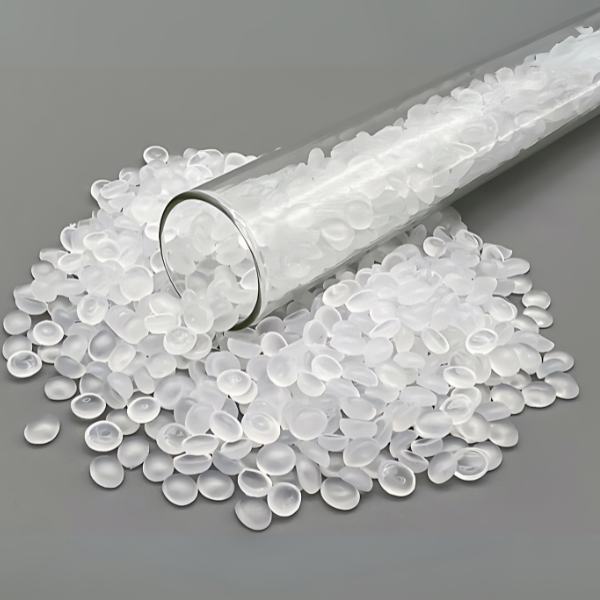Definition
What is BOPP Film?
BOPP stands for “Biaxially Oriented Polypropylene“, which refers to a film made from polypropylene that is stretched in both vertical and horizontal directions. Its production involves extruding molten polypropylene through a narrow die to form a sheet or thick film, which is then stretched in both directions (longitudinally and laterally) in a special stretcher at specific temperatures and speeds. The film is subsequently cooled or heat-treated and processed (e.g., corona treatment, coating) to achieve its final form.
BOPP film is characterized by its excellent transparency, high strength, durability, superior stretchability, and water resistance. It is commonly used for making food packaging bags, gift wrapping, and printing materials.
What is CPP Film?
CPP film, also known as Cast Polypropylene film or unstretched polypropylene film, primarily comprises polypropylene as its main processing material. Depending on its application, CPP film can be categorized into General CPP (GCPP), Metalize CPP (MCPP), and Retort CPP (RCPP) among others.
CPP is a polypropylene (PP) film produced in the plastics industry through the cast extrusion process. Unlike BOPP (Biaxially Oriented Polypropylene) film, it is a non-oriented film. Strictly speaking, CPP film has some orientation in the longitudinal direction (MD). By rapidly cooling on a chill roll, the film acquires excellent clarity and smoothness.
CPP film has good moisture resistance, heat sealing properties, and antistatic properties, and is commonly used for making bread bags, vegetable bags, stationery bags, etc.
Differences Between BOPP and CPP
Manufacturing Process
BOPP film is produced by forming polypropylene granules into sheets, which are then biaxially stretched at high temperatures. Biaxial stretching means that the film is stretched in both longitudinal and lateral directions to achieve improved physical properties.
CPP film is also made from polypropylene granules formed into sheets, but it is typically stretched in only one direction, usually longitudinally. This results in better performance in the longitudinal direction of the film.
Physical Properties
BOPP film: Exhibits high transparency and gloss, excellent ink and coating adhesion, and good stretchability.
CPP film: Due to unidirectional stretching, it may be slightly less transparent than BOPP but has better longitudinal stretching and tear resistance. CPP film features good transparency, high gloss, stiffness, moisture barrier, excellent heat resistance, barrier properties, and mechanical adaptability, suitable for high-temperature cooking and low-temperature heat sealing. Additionally, its resistance to acids, alkalis, and fats makes it a preferred material for bread packaging and composite materials. It is safe for food contact and does not alter the flavor of the contents, with different grades of resin available to achieve desired properties.
Application Fields
BOPP film: Widely used in food packaging, printing, tapes, labels, and other areas, especially those requiring high transparency.
CPP film: Typically used in food packaging.
Heat Sealing Performance
BOPP film: Generally has poor heat sealing performance and requires the addition of a heat-seal coating during manufacturing.
CPP film: Due to its unidirectional stretching, it usually has better heat sealing performance and does not require an additional heat-seal coating.
Film Characteristics
BOPP film: Usually thinner and may require increased thickness for certain specific applications.
CPP film: Relatively thicker, usually with better moisture barrier properties.
Here is a comparative analysis table of BOPP and CPP films across various dimensions:
| Feature/Attribute | BOPP Film | CPP Film |
| Material Composition | Biaxially oriented polypropylene | Cast polypropylene |
| Manufacturing Process | Biaxial orientation (longitudinal and transverse) | Casting (uniaxial orientation) |
| Physical Properties | High strength, high transparency | Good flexibility and transparency, lower barrier properties |
| Heat Resistance | Good heat resistance | Slightly lower heat resistance than BOPP |
| Applications | Widely used in food packaging, labels, cigarette packaging, etc. | Commonly used in clothing packaging, stationery packaging, flower packaging, etc. |
| Printing and Processing Suitability | Requires corona treatment to improve printability | Better direct printability |
| Environmental Friendliness | Recyclable, environmentally friendly | Also recyclable, environmentally friendly |
| Cost | Relatively higher due to more complex production processes | Lower cost due to simpler production processes |
| Market Demand | High demand, especially in the food and pharmaceutical packaging industries | Growing demand, particularly in non-food packaging areas |
Types of BOPP and CPP Films
Types of BOPP Films
Heat Sealable Film
Heat-sealable film is one of the basic varieties of BOPP film, mainly used for printing, composite bag-making, or wrapping packaging. It is divided into single-sided heat-sealable film and double-sided heat-sealable film. The single-sided heat-sealable film, after printing patterns on the non-heat-sealable layer, is laminated with PE, BOPP, and aluminum foil to make bags for packaging food, tea, beverages, etc.
The double-sided heat-sealable film is directly heat-sealed into shaped packaging for food, textiles, audio-visual products, poker, etc. All of these require the film to have good heat-sealing performance. In addition, with the high-speed packaging, BOPP heat-sealable film is also required to have high slip performance, low-temperature instantaneous heat-sealing performance, and better heat-sealing strength. To adapt to different types of packaging machines, the film is required to have a wide heat-sealing temperature range (60-135°C).
In the production of BOPP heat-sealable film, the selection of surface materials is key, including the type of heat-sealing material, production adaptability, heat-sealing temperature, heat-sealing layer thickness, heat-sealing strength, etc. At the same time, appropriate additives should also be selected to improve other properties of the film, such as slipperiness, antistatic properties, stiffness, optical properties, etc.
Anti Fog Film
The issue of condensation in food packaging affects the preservation and appearance of food, while also providing favorable conditions for microbial growth, leading to food spoilage. The emergence of BOPP anti-fog film addresses this problem, not only preventing condensation but also possessing antibacterial properties, widely used in the packaging of fresh fruits and vegetables.
Characteristics of BOPP anti-fog film:
- Good anti-fog effect (can prevent fogging in both cold and hot conditions), excellent gloss and transparency, good printability;
- Good water vapor barrier properties, maintaining the moisture content of fruits and vegetables, preventing dehydration and shrinkage;
- Suitable oxygen permeability, maintaining the respiration of fruits and vegetables;
Suitable surface friction coefficient; - Can have heat sealing properties;
- Contains antibacterial substances, providing antibacterial function;
- Good flexibility, adhering closely to the packaged items;
- More environmentally friendly than PVC.
Ultra-thin High Matte Film
With the improvement of people’s living standards, ordinary packaging can no longer meet the needs of people’s lives, and the demand for paper-plastic soft packaging in the market is increasing. To meet this requirement, many manufacturers have developed various new products, among which BOPP matte film is one.
It appears like paper and silk, noble and elegant, with good printing and laminating performance, low gloss and high haze on the surface, good antistatic and easy folding properties. It is mainly used for paper-plastic lamination of books, advertising brochures, gift bags, etc., and can also be laminated with other substrates for packaging of food, clothing, and crafts.
BOPP matte film requires good effects, uniform mattness, fine surface, excellent haze performance; good printing and laminating performance on the non-matte side, smooth surface adhesion; good stiffness, minimizing thickness for easy lamination processing; excellent mechanical properties, good durability; no defects in appearance, especially in combination with dark paper; good performance of UV ink or hot stamping processing on the matte side, etc.
For easy lamination processing and low-cost considerations, BOPP matte film thickness should be as thin as possible. Currently, the thickness of domestic BOPP matte film can reach 15um, and abroad there is BOPP matte film with good performance and a thickness of 12um.
To achieve a thin thickness of BOPP matte film, good matte effect, and adapt to wide-format, high-speed production, the selection of main and matte materials, and control of production process conditions are key, and attention should also be paid to the reasonable match of additives, to produce BOPP matte film with low gloss, high haze, good stiffness, antistatic, easy folding, and fine surface.
Twist Film
Used for twist wrapping of candies, chocolates, beef jerky, preserved fruits, and snacks, replacing environmentally unfriendly PVC twist films and expensive cellophane twist packaging. Film characteristics: good twistability; good stiffness, strong rigidity; high gloss; and good aluminum plating performance.
Straw Packaging Film
Directly used for transparent heat-seal packaging of straws. Film characteristics: good optical properties, suitable friction coefficient, and heat-seal strength.
Release Film
Used as a silicone oil release film for the protection of plasters, labels, silent adhesive tapes, and other adhesive-backed products. Film characteristics: good thermal dimensional stability; high stiffness; flawless appearance.
Barrier Protection Film
Used for winding and molding isolation protection of fishing rods, golf clubs, and other industrial products. Film characteristics: good thermal dimensional stability; high tensile strength; flawless appearance.
Heat-Sealable Aluminum Film
Can be directly used for heat-seal bag packaging of food, replacing CPP aluminum composite film.
Low-Static Film
Suitable for packaging electronic components. Surface resistivity is less than 10^10Ω.
UV-Resistant Film
Used for transparent packaging of products that require protection against ultraviolet rays or for outdoor use.
Antibacterial Film
Used for packaging cooked meats, seafood, and liquid foods. It is a new type of functional material that has antibacterial and bacteriostatic effects, but is non-toxic to humans.
High Transparency Film
Used for the production of high transparency adhesive tapes and the lamination of paper products. Haze is less than 0.3%.
Low Migration Film
Reduces the migration of additives, maintaining good optical performance of the film during its packaging life without contaminating the packaged items, meeting the hygiene requirements for food and pharmaceutical packaging.
Temperature-Resistant Flame-Retardant Film
Used in fields requiring temperature resistance and flame retardance, such as the drying and curing of circuit boards or electronic components.
Label Film
Used as wrap-around labels for bottled beverages. Film characteristics: good printing performance, high stiffness, high whiteness, high gloss, low static electricity, and good slipperiness.
Types of CPP Films
Lamination Grade
Laminated with printed BOPP film or BOPET film to form a BOPP/CPP (or BOPET/CPP) two-layer film, used for clothing and dry food packaging. The typical structure is heat-sealable PP/homopolymer PP/copolymer or homopolymer PP.
Based on the heat-sealing temperature, it can be classified into standard heat-sealable film (heat-sealing temperature 135°C), low-temperature heat-sealable film (heat-sealing temperature 120-130°C), and ultra-low temperature heat-sealable film (heat-sealing temperature below 120°C). By selecting different materials for the heat-sealing layer, the heat-sealing temperature of CPP can be reduced to below 100°C.
Aluminized Grade
CPP film has good barrier properties against water vapor permeation, but its barrier performance against oxygen permeation is relatively poor. After vacuum aluminum metallization, the film’s oxygen barrier properties are significantly improved. Metalized products have excellent light-shielding, decorative, and barrier properties and show good adaptability in post-processing such as printing and lamination, meeting requirements for heat resistance, chemical resistance, abrasion resistance, oxidation resistance, and high barrier properties.
The product surface requires a strong adhesion strength to the vapor-deposited aluminum, maintaining good dimensional stability and rigidity after metallization. The other surface should have a lower heat-sealing temperature and higher heat-sealing strength. The structure of the aluminized grade CPP film is copolymer PP/homopolymer PP/copolymer PP.
Retort Grade
Laminated with barrier films such as PA or aluminum foil for packaging products that require high-temperature retort sterilization, commonly used for foods containing fats or sauces. Retort-grade CPP films can generally be classified into an ordinary retort, medium-high temperature retort, and high-temperature retort. Ordinary retort withstands temperatures below 121°C, medium-high temperature retort withstands 121°C to 135°C for 130 minutes, and high-temperature retort withstands 135°C for 30 minutes. Retort-grade CPP films use random copolymer PP material, while high-temperature retort-grade CPP films use block copolymer PP material.
Printing Grade
CPP films with higher stiffness can be used alone for the outer packaging of food, clothing, sanitary napkins, flowers, etc., after printing and bag making. Depending on the requirements, the film features high transparency, antistatic properties, and customer-specified friction coefficients.
Other Functional Films
Antistatic CPP films are produced by adding an antistatic masterbatch.
High-rigidity CPP films are produced by adding rigidity-enhancing masterbatch and controlling the processing and molding temperature to increase the film’s rigidity, suitable for direct printing and used for packaging paper towels or twist wrapping.
Anti-fog CPP films
Anti-freeze CPP films are produced by blending and modifying with POE to improve resistance to low temperatures and are suitable for refrigerated and frozen food packaging.
Co-extruded films with PE
Conclusion
In this blog, we have explored the unique characteristics and applications of BOPP and CPP films, both of which are widely used in the packaging industry.
BOPP is renowned for its high strength and transparency and is primarily used in food packaging, labels, and cigarette packaging. Its production process, involving biaxial stretching, contributes to its superior physical properties and heat resistance.
On the other hand, CPP stands out for its flexibility and direct printability, making it particularly suitable for packaging apparel, stationery, and floral products. While both films are environmentally friendly and recyclable, BOPP tends to be more costly due to its complex production process, in contrast to CPP, which is more economical to produce.








